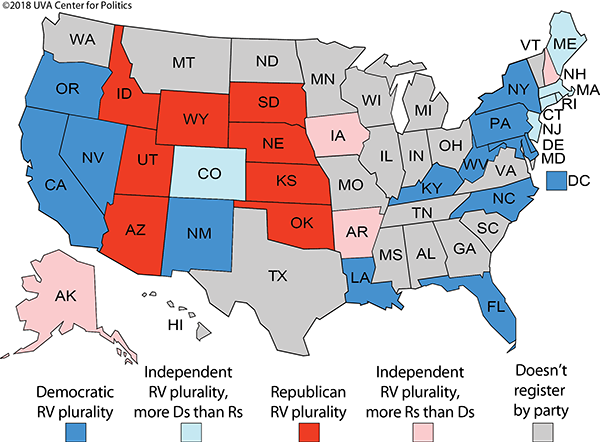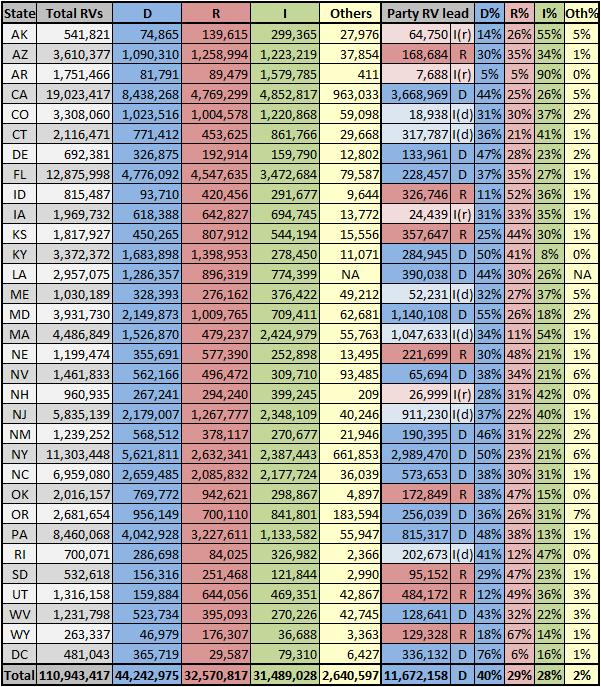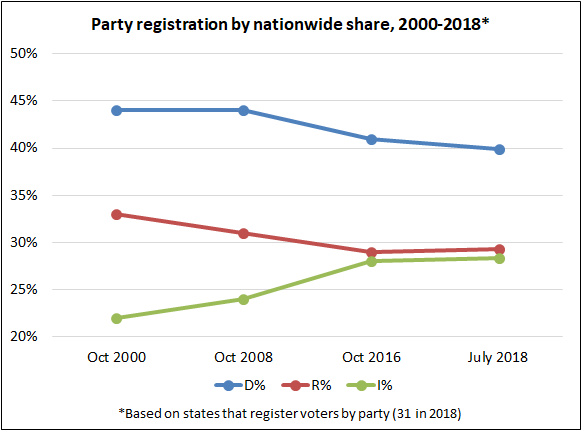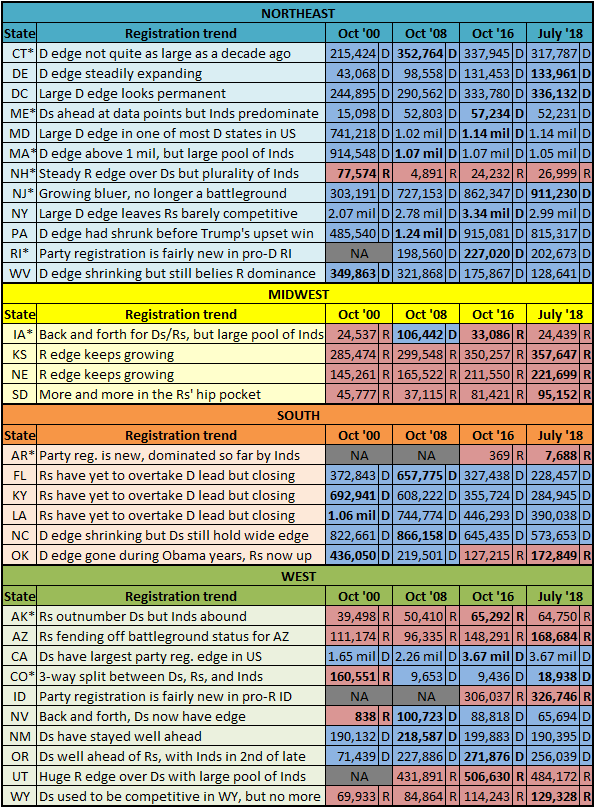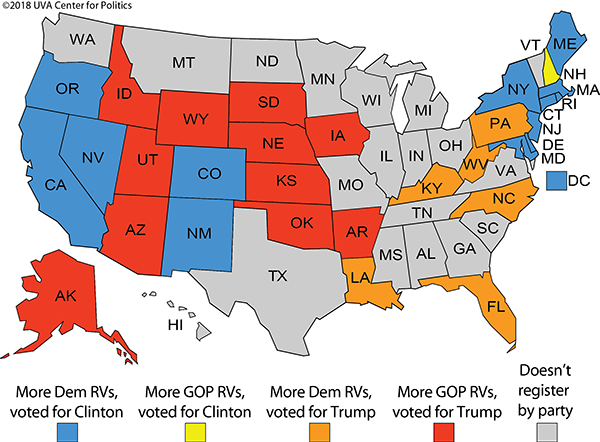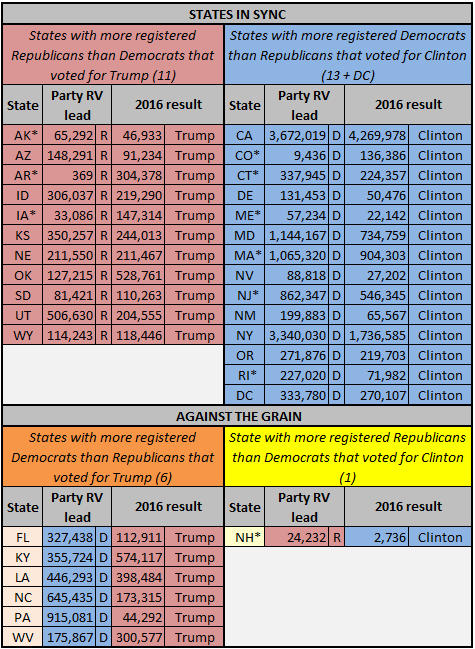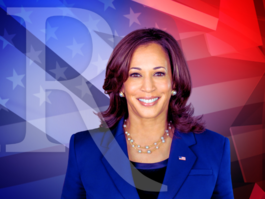Registering by Party: Where the Democrats and Republicans Are Ahead
A Commentary By Rhodes Cook
KEY POINT FROM THIS ARTICLE
— Altogether, there are 31 states (plus the District of Columbia) with party registration; in the others, such as Virginia, voters register without reference to party. In 19 states and the District, there are more registered Democrats than Republicans. In 12 states, there are more registered Republicans than Democrats. In aggregate, 40% of all voters in party registration states are Democrats, 29% are Republicans, and 28% are independents. Nationally, the Democratic advantage in the party registration states approaches 12 million.
Poring over party registration
This is not the best of times for the Democratic Party. No White House; no Senate; no House of Representatives; and a clear minority of governorships and state legislatures in their possession. Yet the Democrats approach this fall’s midterm elections with an advantage in one key aspect of the political process — their strength in states where voters register by party.
Altogether, there are 31 states (plus the District of Columbia) with party registration; in the others, such as Virginia, voters register without reference to party. Among the party registration states are some of the nation’s most populous: California, New York, Florida, North Carolina, Pennsylvania, New Jersey, Arizona, and Massachusetts.
The basic facts: In 19 states and the District, there are more registered Democrats than Republicans. In 12 states, there are more registered Republicans than Democrats. In aggregate, 40% of all voters in party registration states are Democrats, 29% are Republicans, and 28% are independents. Nationally, the Democratic advantage in the party registration states approaches 12 million.
Still, Republican Donald Trump found a route to victory in 2016 that went through the party registration states. He scored a near sweep of those where there were more Republicans than Democrats, winning 11 of the 12, while also taking six of the 19 states where there were more Democrats than Republicans — a group that included the pivotal battleground states of Florida, North Carolina, and Pennsylvania.
Map 1 and Table 1: Party registration totals by state, July 2018
Democrats no longer control the White House, the Senate, the House of Representatives, or for that matter most of the governorships or state legislatures. But they still maintain a toehold in the political process with their edge in the realm of voter registration. At least that is the case in the 31 states and the District of Columbia that register voters by political party. As of this month, 13 of these states (plus the District) boast a Democratic plurality in registered voters, compared to eight states where there is a Republican plurality. In the other 10 states, there are more registered independents than either Democrats or Republicans, with Democrats out-registering the Republicans in six of these states and the GOP with more voters than the Democrats in the other four. They are indicated in the chart as “I(d)” or “I(r).” Nationally, four out of every 10 registered voters in party registration states are Democrats, with slightly less than three out of every 10 registered as Republicans or independents. Overall, the current Democratic advantage over Republicans in the party registration states approaches 12 million.
Sources: Recent party registration numbers used here are from state election websites and are based on totals compiled in early July 2018. Registration data are as of the following months: October 2016 (Kansas and Rhode Island); February 2017 (Massachusetts); November 2017 (Connecticut); January 2018 (Oklahoma); March 2018 (Arizona and Maine); April 2018 (New Hampshire and New York); May 2018 (California, Florida, Maryland, Nebraska, and Pennsylvania); June 2018 (Arkansas, District of Columbia, Kentucky, New Jersey, New Mexico, North Carolina, and West Virginia); and July 2018 (Alaska, Colorado, Delaware, Idaho, Iowa, Louisiana, Nevada, Oregon, South Dakota, Utah, and Wyoming).
Notes: In states such as Arizona, Colorado, Connecticut, Iowa, Maine, Nevada, New York, Rhode Island, South Dakota, and Utah, the total number of active and inactive voters are presented on the state election website, but only the number of active registered voters is used in this article. The “other” column includes voters registered with third parties. Percentages do not always add to 100 due to rounding. Zero percent (0%) indicates less than 0.5%. “NA” indicates there were no numbers in this category.
Some caveats
At this point, it might be wise to pause and ask the question: Why do these numbers matter, either individually or in the aggregate?
Certainly there are facts that argue that they should be taken with a grain or two of salt. Most party registration states are found in more Democratic terrain: the Northeast (11 states plus the District of Columbia) and the West (10 states), followed by the South (six states) and the Midwest (four states), all of the latter rural states west of the Mississippi River.
To be sure, there are a number of major states that do not register voters by party, such as Texas, Georgia, Washington, and the keystones of the industrial Midwest: Illinois, Indiana, Michigan, Ohio, and Wisconsin. If they did register by party, Texas, Georgia, and Indiana would almost certainly add to the Republican total; the industrial states probably less so.
Comparing party registration totals between states at a particular point in time can be a bit misleading, particularly because some may have recently completed a purge of “dead wood” on their rolls while others have not. Often, the trend line over a series of years is more valuable to look at than a one-time registration count.
States can also differ on how they report active versus inactive voters. Basically, the latter have not voted in several consecutive elections and have not responded to the efforts of election officials to reach them, though they are generally allowed to show up and vote if they have not moved. Some states fold in active with inactive voters to produce one grand total. A few states break the two categories out separately, where the number of active voters routinely dwarf the number of inactive voters, sometimes by a ratio in excess of 10 to 1. (This article uses only state totals of active voters, wherever possible.)
And there is some sentiment that a voter’s party identification may mean less than it once did, as the number of individuals who register as “Independent” (or “No Party Preference,” “Unaffiliated,” or whatever other nom de plume the individual states prefer) steadily grows. At the beginning of this century, barely 20% of all voters in party registration states were independents. Nowadays, that total is approaching 30%.
Altogether, there are 10 states with more registered independents than either Democrats or Republicans. These states are mainly in the Northeast, with a cluster also in the West. By comparison, there are Democratic pluralities of registered voters in 13 states plus the District of Columbia and eight other states with Republicans ahead of both Democrats and independents. In addition, there are six states where there is an independent plurality but Democrats outnumber Republicans, and four states where independents are on top of the registration totals but Republicans outnumber Democrats. That produces the 19 to 12 state registration advantage for the Democrats mentioned earlier.
With the growth in independents, many voters seem to be saying to the two major parties: “a pox on both your houses.”
Yet it also can be argued that registering Democratic or Republican is far more of a statement than it once was. In the current age of sharp-edged partisanship, there is far more than a “dime’s worth of difference” between the two major parties, so registering as a Democrat or Republican is a very intentional act of differentiation.
And that makes the party registration figures worth looking at. A comparison of party registration totals on the eve of the 2016 presidential election with the actual voting in November shows a noticeable correlation between party registration and the state by state election outcomes. Twenty-four of the 31 party registration states were won by the nominee whose party had more registered voters (discounting independents for this particular comparison). That is a 77% correlation rate between party registration advantage and a winning electoral outcome. The percentage goes up to 88% if one removes the South, the one area of the country where party registration is a lagging indicator of the fortunes of the two major parties.
Chart 1 and Table 2: Nationwide party registration trends since 2000
Since 2000, the nationwide proportion of registered Democratic and Republican voters in party registration states have both gone down, while the percentage of registered independents has steadily grown. The latter has nearly reached the nationwide percentage of registered Republicans, which has long been second nationally to the Democrats. Altogether, the combined number of registered Democrats and Republicans, which was 77% in October 2000, is now down to 69%, while the proportion of registered independents over the same period has increased from 22% to 28%.
Note: Based on active registered voters in states where the number of active and inactive registrants is listed. In the election-eve 2000, 2008, and 2016 entries, “Independents” include a comparatively small number of registered miscellaneous voters who do not fit into a particular category. Percentages do not add to 100 since the small percentage of registered third party voters is not included.
Sources: Richard Winger’s monthly newsletter, Ballot Access News, for election-eve party registration numbers in 2000, 2008, and 2016; the websites of state election offices for July 2018.
Southern exceptionalism
Even though Democrats began losing their dominance in the South a half century ago, they still retain a registration advantage in four of six Southern states where voters register by party: Florida, Kentucky, Louisiana, and North Carolina.
In Arkansas, there is a rudimentary system of party registration in which there are a few more Republicans than Democrats, but a vast majority of voters do not identify with either party. In Oklahoma, one of the reddest of states over the last few decades, the party registration advantage did not finally flip from Democratic to Republican until a few years ago during Barack Obama’s presidency. (Oklahoma is the only state this century where the registration advantage has switched between parties and the Republican lead is likely to hold for the long term. In battleground states such as Colorado, Iowa, and Nevada, the registration advantage has switched at least once between parties since 2000 and has less of a look of permanence.)
It is an open question as to why other party registration states in the South have not also flipped to the Republicans. For years, they have been regularly voting for GOP candidates up and down the ballot, including 2016 when the whole region except Virginia went for Trump. White southerners who once registered en masse for the Democrats have been dying off for years. And the time when voters registered Democratic because its primary was tantamount to election is long gone. Still, in booming states such as Florida and North Carolina, an influx of outsiders registering Democratic could be helping the party fend off a large GOP registration surge that would flip the states to the Republicans.
As it is, Republicans have been steadily whittling away at the Democrats’ registration advantage in the Southern party registration states. In Florida, the GOP deficit is now less than 230,000 registered voters after being nearly 660,000 in October 2008. In North Carolina, Republicans trail by less than 575,000 registered voters, after being down by 865,000 a decade ago; while in Kentucky and Louisiana, the GOP registration deficit nowadays is below 300,000 and 400,000 registrants, respectively, less than half of what it was in each state on the eve of the 2000 election.
Table 3: State-by-state registration trends since 2000
The nationwide Democratic registration edge has been fashioned on the two coasts, where they have had their greatest electoral success of late. In California alone, the Democratic registration plurality of less than 1.7 million voters in October 2000 has more than doubled to nearly 3.7 million. In New York, the Democratic registration advantage swelled from barely 2 million at election-eve 2000 to almost 3 million nowadays. Beyond much of the Northeast and West, Democrats have also retained an advantage in a number of party registration states in the South, where they dominated long ago at the ballot box but have been running on fumes for years. The Democratic registration edge in Florida, Kentucky, Louisiana, and North Carolina has been steadily eroding in recent decades yet still exists.
Notes: The largest Democratic and Republican registration margins among the four data points are in bold. An asterisk (*) indicates that in July 2018, there were more voters registered as independent than Democratic or Republican. “NA” indicates that party registration figures are not readily available. Party registration totals are based on the number of active voters in states where totals for both active and inactive voters are posted.
Sources: Election-eve party registration figures for 2000, 2008, and 2016 were compiled by Richard Winger and published in his bimonthly newsletter, Ballot Access News. The July 2018 data were compiled by the author from party registration numbers posted on state election websites (see Sources note for Map 1 and Table 1).
Lots of consistency elsewhere
In the rest of the country, there was much more consistency between party registration totals and the 2016 election outcome, with only three non-Southern states voting “against the grain.” On election eve in Pennsylvania, there were 915,081 more registered Democrats than Republicans; Trump carried the state by 44,292 votes. In West Virginia, there were 175,867 more registered Democrats; Trump won by 300,577 votes. And in New Hampshire, there were 24,232 more registered Republicans than Democrats in the fall of 2016, but Hillary Clinton took the state by 2,736 votes. That’s it. The other 22 party registration states outside the South were carried in the presidential balloting by the party with more registered voters than the other.
And in many of these “in sync” states, the registration advantage in recent years has grown more Republican or Democratic as the case may be, augmented by a healthy increase in independents.
Case in point: California. Eighteen years ago, 45% of the state’s 15.7 million registered voters were Democrats, 35% were Republicans, and 14% were independents. Last month, on the eve of California’s June 5 primary, 44% of the 19.0 million registered voters were Democrats (down one percentage point from 2000), 25.5% were independents (up 11 points), and 25% were Republicans (down 10 points), as the Republicans dropped to third place in California registration totals and independents rose to second. In the process, the nation’s most populous state has gone from one that was vaguely competitive for the Republicans at the beginning of the 21st century to one where Republicans have trouble competing statewide at all.
The registration trend line in California is a microcosm of sorts of party registration in the nation as whole. Democrats are running ahead and the ranks of the independents are growing. Yet registered voters in both parties appear to be widely engaged. That was the case in 2016, and likely will be again in 2018, with Trump flogging issues to rouse his base. In short, this is a highly partisan era when party registration totals, and the trends that go with them, are well worth watching.
Map 2 and Table 4: Party registration and the 2016 presidential vote
Of the 31 party registration states, 24 were carried in the 2016 presidential election by the party with the most registered voters in it. Donald Trump swept 11 of the 12 states with a Republican registration advantage, while Hillary Clinton won 13 of the 19 states (plus the District of Columbia) which had more registered Democrats than Republicans. Four of the Democratic registration states that Trump took were in the South, led by Florida and North Carolina. He also overcame Democratic registration advantages in West Virginia and Pennsylvania to win both. The only state with more registered Republicans than Democrats that Hillary Clinton carried in 2016 was New Hampshire, where the outcome was very close.
Notes: An asterisk (*) indicates states where there were more registered independents than either Democrats or Republicans in October 2016. “Independents” include a comparatively small number of registered miscellaneous voters who do not fit into any particular category.
Sources: Richard Winger’s Ballot Access News for October 2016 party registration data; America Votes 32 (CQ Press, an imprint of SAGE) for 2016 presidential election results.
See Other Commentary by Rhodes Cook.
See Other Political Commentary.
Views expressed in this column are those of the author, not those of Rasmussen Reports.
Rasmussen Reports is a media company specializing in the collection, publication and distribution of public opinion information.
We conduct public opinion polls on a variety of topics to inform our audience on events in the news and other topics of interest. To ensure editorial control and independence, we pay for the polls ourselves and generate revenue through the sale of subscriptions, sponsorships, and advertising. Nightly polling on politics, business and lifestyle topics provides the content to update the Rasmussen Reports web site many times each day. If it's in the news, it's in our polls. Additionally, the data drives a daily update newsletter and various media outlets across the country.
Some information, including the Rasmussen Reports daily Presidential Tracking Poll and commentaries are available for free to the general public. Subscriptions are available for $4.95 a month or 34.95 a year that provide subscribers with exclusive access to more than 20 stories per week on upcoming elections, consumer confidence, and issues that affect us all. For those who are really into the numbers, Platinum Members can review demographic crosstabs and a full history of our data.
To learn more about our methodology, click here.
